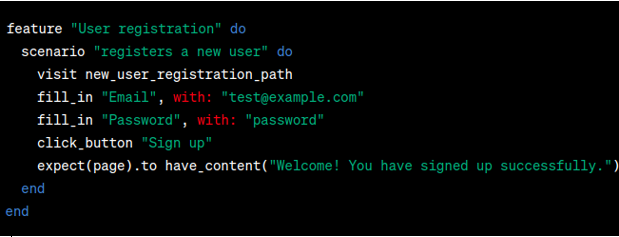Test-Driven Development (TDD) with Ruby on Rails: Building Robust and Stable Applications
2023-01-18

Test-Driven Development (TDD) has emerged as a cornerstone of modern software development practices. With its ability to ensure code quality, improve collaboration, and enhance the overall development process, TDD has gained widespread adoption, especially in the Ruby on Rails community. In this article, we will delve deep into the world of TDD in Ruby on Rails, exploring its history, benefits, process, tools, challenges, and best practices.
What is Test-Driven Development?
Test-Driven Development (TDD) is a software development methodology that emphasizes writing tests before writing the actual code of an application. In TDD, developers follow a specific cycle, commonly known as the "Red-Green-Refactor" cycle, to guide the development process. The main idea behind TDD is to ensure that each piece of code is thoroughly tested and functional, leading to more reliable, maintainable, and high-quality software.
TDD is not only about testing; it's a design methodology that drives the development process. By focusing on writing tests that validate specific behaviors, developers ensure that the codebase remains stable, maintainable, and adaptable to future changes. TDD can be applied to various levels of testing, including unit testing (testing individual components), integration testing (testing interactions between components), and acceptance testing (testing the application's overall behavior).
History of Test-Driven Development
-
Emergence of TDD Concepts (Late 1990s):
The origins of TDD can be traced back to the work of Kent Beck, who is often credited with formalizing and popularizing the methodology. In his book "Extreme Programming Explained," published in 1999, Beck introduced the concept of writing tests before writing code. This was a radical departure from the conventional practice of writing code and then testing it. -
Early Adoption in Extreme Programming (Early 2000s:
TDD gained prominence as a core practice within the Extreme Programming (XP) methodology. XP emphasized rapid iterations, customer collaboration, and the importance of automated testing. TDD perfectly aligned with these principles by enabling developers to iteratively create well-tested and functional code. -
Mainstream Recognition and Tools (Mid-2000s):
As agile methodologies gained traction in the mid-2000s, TDD received greater recognition in the software development community. Frameworks and testing libraries emerged to support TDD practices. For instance, JUnit for Java and NUnit for .NET provided tools for writing and executing unit tests in a structured manner. -
Integration with Development Workflows (Late 2000s):
TDD became an integral part of many development workflows. As the practice gained wider adoption, more teams recognized its benefits in terms of code quality, bug prevention, and enhanced collaboration between developers and testers. -
Diversification of Testing Tools (2010s):
The 2010s saw an expansion of tools and libraries that supported TDD in various programming languages and frameworks. For example, RSpec for Ruby, Jasmine for JavaScript, and PyTest for Python provided specialized testing capabilities tailored to specific languages. -
Shift to Continuous Integration and Delivery (2010s – Present):
TDD seamlessly integrated with continuous integration and continuous delivery (CI/CD) practices. Automated testing, including unit tests created through TDD, became a crucial aspect of ensuring code stability and reliability in rapidly changing software environments. -
Modern TDD Practices (Present):
In modern software development, TDD is considered a standard best practice. The methodology has evolved to encompass not only unit testing but also integration testing, acceptance testing, and more. Developers now use TDD to drive the design of their software, improve the maintainability of their codebase, and enhance their ability to respond to changing requirements.
Understanding Test-Driven Development(TDD)
At its core, TDD is a development approach that advocates writing tests before writing the actual application code. The process is cyclic and typically follows three main steps: Red, Green, and Refactor.
-
Red:
In this initial phase, developers write a test that describes a specific functionality or behavior they want to implement. Since there is no corresponding code yet, the test inevitably fails, represented by a "red" status. -
Green:
After writing the failing test, developers proceed to write the minimum amount of code necessary to make the test pass. This code might not be elegant or optimal; its sole purpose is to achieve a "green" status for the test. -
Refactor:
With the test now passing, developers can improve the code's structure, efficiency, and readability without affecting the test's outcome. The tests act as a safety net, catching any regressions caused by refactoring.
Benefits of TDD in Ruby on Rails Development
TDD offers a multitude of advantages when applied to Ruby on Rails development:
-
Clarity of Requirements:
TDD encourages developers to clearly define the expected behavior of their code before implementation. This helps prevent scope creep and ensures that the development team and stakeholders are on the same page. -
Reliability:
The comprehensive test suite resulting from TDD provides a safety net against unexpected regressions. Each piece of functionality is covered by one or more tests, reducing the likelihood of bugs slipping through unnoticed. -
Confidence:
With a solid test suite in place, developers can make changes to the codebase with confidence. They can quickly identify if any modifications break existing functionality, allowing for faster debugging and resolution. -
Documentation:
Tests serve as living documentation for the codebase. New developers can quickly understand how different parts of the application are intended to work by studying the tests associated with them. -
Maintainability:
TDD promotes modular and loosely coupled code, making the application more maintainable in the long run. When a change is required, developers can rely on tests to guide their modifications without fear of introducing defects.
TDD in Practice: Tools and Techniques
In the Ruby on Rails ecosystem, the testing landscape is rich with tools and libraries that facilitate TDD:
1. Rspec:
RSpec is a widely used testing framework in the Ruby community. It provides a readable and expressive syntax for writing tests. With its "describe," "context," and "it" blocks, RSpec allows developers to structure their tests in a narrative style that closely resembles natural language. An example RSpec test:

2. Capybara:
Capybara is a popular tool for integration testing in Rails applications. It simulates user interactions with the application, such as filling out forms and clicking buttons, to ensure that the entire stack is functioning as expected. An example Capybara test:

3. FactoryBot:
FactoryBot is a library for setting up test data easily and efficiently. It allows developers to define factories that generate sample data for testing. This simplifies the process of creating test objects and ensures that the data is consistent and valid. An example FactoryBot test:

Best Practices for Successful TDD Implementation
To maximize the benefits of TDD in Ruby on Rails development, follow these best practices:
-
Start Small:
Begin with simple test cases and gradually move to more complex scenarios. This gradual approach helps build a strong foundation for your test suite. -
Focus on Behavior:
Write tests that describe the behavior of your application, not just its implementation details. This ensures that your tests remain relevant even as your code evolves. -
Use Descriptive Names:
Give your tests and methods descriptive names that convey their purpose. This improves readability and makes the test suite a valuable form of documentation. -
One Test at a Time:
Follow the Red-Green-Refactor cycle for each test individually. This helps maintain focus and ensures that your tests are always in a reliable state. -
Avoid Testing Frameworks:
While testing frameworks are powerful, it's best to avoid relying on them too heavily. Your tests should primarily test your application's behavior, not the underlying framework's functionality. -
Refactor Fearlessly:
Take advantage of the safety net provided by your tests to refactor your code with confidence. Refactoring should improve code quality without affecting functionality. -
Keep Tests Fast:
Slow tests can hinder productivity. Strive to keep your test suite fast by using techniques like test doubles (mocks and stubs) for isolating dependencies.
Conclusion
Test-Driven Development is a proven methodology that empowers developers to build robust, reliable, and maintainable Ruby on Rails applications. By writing tests before writing code, developers establish a solid foundation of expectations for their software's behavior. This approach not only prevents regressions but also promotes better code organization, increased collaboration, and faster debugging. The Ruby ecosystem offers a range of tools and libraries, such as RSpec, Capybara, and FactoryBot, to facilitate effective TDD implementation. Following best practices, developers can harness the full potential of TDD and elevate the quality of their Rails applications to new heights. In the ever-evolving landscape of software development, TDD remains a timeless technique that continues to shape how developers approach challenges, collaborate, and produce software that stands the test of time.

